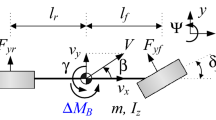Abstract
This paper presents a coordinated control of electronic stability control (ESC) and active front steering (AFS) with adaptive algorithms for yaw moment distribution in integrated chassis control (ICC). In order to distribute a control yaw moment into control tire forcres of ESC and AFS, and to coordinate the relative usage of ESC to AFS, a LMS/Newton algorithm (LMSN) is adopted. To make the control tire forces zero in applying LMS and LMSN, the zero-attracting mechanism is adopted. Simulations on vehicle simulation software, CarSim®, show that the proposed algorithm is effective for yaw moment distribution in integrated chassis control.
Similar content being viewed by others
Abbreviations
- C f, C r :
-
cornering stiffness of front/rear tires (N/rad)
- e k :
-
adaptation error at time instant k
- F x, F y, F z :
-
longitudinal/lateral/vertical tire forces (N)
- F yf, F yr :
-
lateral tire force of front/rear wheels (N)
- G :
-
effectiveness matrix
- I :
-
identity matrix
- I z :
-
yaw moment of inertial (kg×m2)
- J 1, J 2 :
-
objective functions of adaptive algorithms
- K γ :
-
steady-state yaw rate gain (1/s)
- K :
-
gain in sliding mode control
- K B :
-
pressure-force constant (N×m/MPa)
- l f, l r :
-
distance from C.G. to front/rear axles (m)
- m :
-
vehicle total mass (kg)
- P B :
-
brake pressure (MPa)
- H :
-
weighting matrix in LLMS
- Q, R :
-
auto-correlation and cross-correlation matrices in LMSN and ZA-LMSN
- r w :
-
radius of a wheel (m)
- s :
-
sliding surface
- 2t f, 2t r :
-
front/rear track widths (m)
- V :
-
vehicle velocity (m/s)
- v x, v y :
-
longitudinal/lateral velocities of a vehicle (m/s)
- w :
-
vector of the control tire forces
- β :
-
side-slip angle (rad)
- δ f :
-
steering angle of front wheels (rad)
- Δδ f :
-
corrective steering angle by AFS (rad)
- ΔF x :
-
longitudinal tire force by ESC (N)
- ΔF yf :
-
lateral tire force by AFS (N)
- ΔM B :
-
control yaw moment
- γ, γ d :
-
real and reference yaw rates (rad/s)
- η :
-
tuning parameter on side-slip angle
- ε :
-
convergence rate of LMS and its variants
- ρ :
-
tuning parameter on zero-attracting term
- μ :
-
tire-road friction coefficient
References
Chen, Y., Gu, Y. and Hero, A. O. (2009). Sparse LMS for system identification. Proc. IEEE ICASSP, 3125–3128.
Cho, W., Yoon, J., Kim, J., Hur, J. and Yi, K. (2008). An investigation into unified chassis control scheme for optimised vehicle stability and maneuverability. Vehicle System Dynamics, 46, Supplement, 87–105.
Diniz, P. S. R. (2008). Adaptive Filtering: Algorithms and Practical Implementation. Springer. New York, USA.
Haykin, S. and Widrow, B. (2003). Least-Mean-Square Adaptive Filters. John Wiley and Sons. New Jersey, USA.
MacAdam, C. C. (1981). Application of an optimal preview control for simulation of closed-loop automobile driving. IEEE Trans. Systems, Man, and Cybernetics 11, 6, 393–399.
Mechanical Simulation Corporation (2001). CarSim User Manual Version 5.
Mokhiamar, O. and Abe, M. (2004). Simultaneous optimal distribution of lateral and longitudinal tire forces for the model following control. ASME J. Dynamic Systems, Measurement, and Control, 126, 753–763.
Rajamani, R. (2006). Vehicle Dynamics and Control. Springer. New York, USA.
Schofield, B. (2006). Vehicle Dynamics Control for Rollover Prevention. Ph. D. Dissertation. Lund University. Lund, Sweden.
Shi, K. and Shi, P. (2010). Convergence analysis of sparse LMS algorithms with l1-norm penalty basedon white input signal. Signal Processing 90, 12, 3289–3293.
Uematsu, K. and Gerdes, J. C. (2002). A comparison of several sliding surfaces for stability control. Proc. AVEC, Japan.
Ungoren, A. Y. and Peng, H. (2004). Evaluation of vehicle dynamic control for rollover prevention. Int. J. Automotive Technology 5, 2, 115–122.
Wang, J. and Longoria, R. G. (2006). Coordinated vehicle dynamics control with control distribution. Proc. American Control Conf., 5348–5353.
Wang, J., Solis, J. M. and Longoria, R. G. (2007). On the control allocation for coordinated ground vehicle dynamics control systems. Proc. American Control Conf., 5724–5729.
Widrow, B. and Sterns, S. D. (1985). Adaptive Signal Processing. Prentice-Hall. Englewood Cliffs, New Jersey, USA.
Wong, J. Y. (2001). Theory of Ground Vehicles. John Wiley and Sons. New Jersey, USA.
Yim, S., Choi, J. and Yi, K. (2012). Coordinated control of hybrid 4WD vehicles for enhanced maneuverability and lateral stability. IEEE Trans. Vehicular Technology 61, 4, 1946–1950.
Yim, S. (2015). Unified chassis control with electronic stability control and active front steering for under-steer prevention. Int. J. Automotive Technology 16, 5, 775–782.
Yim, S. (2016). Integrated chassis control with adaptive algorithms. Proc. Institution of Mechanical Engineers, Part D: J. Automobile Engineering 230, 9, 1264–1272.
Author information
Authors and Affiliations
Corresponding author
Rights and permissions
About this article
Cite this article
Yim, S. Coordinated control of ESC and AFS with adaptive algorithms. Int.J Automot. Technol. 18, 271–277 (2017). https://doi.org/10.1007/s12239-017-0027-3
Received:
Revised:
Accepted:
Published:
Issue Date:
DOI: https://doi.org/10.1007/s12239-017-0027-3



